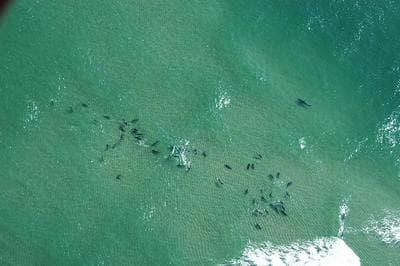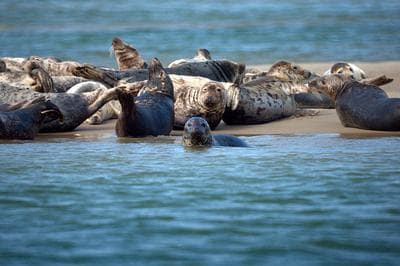Advertisement
To Get To The Heart Of The Great White Shark, Go Through Its Stomach

For the first time since a fatal encounter in 1936, human blood has been drawn by a great white shark in Massachusetts waters. Fortunately, this week’s victim is being treated for non-life-threatening injuries, having suffered severe lacerations to his legs. While shark bites are extremely rare, it probably won’t take another 76 years for the next unprovoked attack locally.
Why? They’re baaaa…ack.
The Return Of The Great White
Great white sharks are not common. They’re predators at the business end of the food chain. By nature, they number far fewer than the populations of prey that support them. State officials have tagged just six in Massachusetts waters this summer. Three tagged last summer have returned. State shark biologist Greg Skomal thinks there might be one or two untagged whites hanging around. That’s fewer than a dozen overall in Massachusetts waters this summer.
But that’s a dozen more than used to skirt the beaches of Chatham and Truro and Orleans. The sharks are back, because the seals are back.

Seals Came First
“When you hear a 95-year-old on the dock in Chatham say he’s never seen this many seals before in his life, he’s telling the truth,” Skomal said. Grey seals were nearly wiped out by 1900. They were competition for valuable fishing stocks. Massachusetts offered bounties on seals until 1962.
But in 1972, a new federal law prevented harming and harassing seals. Over the last 40 years, the grey seal population in Massachusetts has rebounded. They now number in the thousands here.
And following the growing abundance of prey are the predators.
We're Gonna Need A Bigger Acoustic Array
While fishermen complain that the seals are catching their fish, the bigger economic interest is in beach communities, where fear of the sharks on the seals’ tails could take a bite out of tourism dollars.
So Massachusetts has deployed an acoustic array of underwater receivers that pick up the signals of sharks tagged with sound pingers called transponders. But each receiver only detects tagged sharks swimming within a few hundred yards. At $1,400 each, the devices are expensive.
They're also costly to maintain, especially those farther from shore. Some wash away each year. So the state has deployed acoustic receivers where sharks are sighted more often: on the lower half of the eastern edge of the Cape, from Orleans to Monomoy National Wildlife Refuge.
“The problem is,” Skomal said, “… we have no receivers between Orleans and Truro.”
Truro, close to the northern edge of the Cape, is where this week’s attack happened. Skomal thinks the shark mistook the swimmer for a seal.
Advertisement
Sharks: A Tough Study
Truro and other coastal towns want to be able to know when sharks are in the area. They also want to be able to say when sharks are not around.
But based on the patchy acoustic array, and the handful of sharks in the area, it’s difficult for marine biologists to suss out behavioral patterns that could help communities know the probability a shark is in the area.
“When I talk about studying a sample size of nine [tagged sharks], other scientists just laugh at me,” Skomal said.

Statistical Seal Of Approval
Yet there is a population that sharks key in on that offers a much larger sample size: the grey seal. Their colonies along the Massachusetts coast are easier to watch and track. But there hasn’t been systematic observation to lay the groundwork for better shark risk assessment.
“We don’t really know much about the seal behavior and the movement patterns and dynamics," Skomal said. "They move around quite a bit. It’s something we need to learn more about.”
Hungry sharks are after the seals. Knowing more about what drives seal behavior and movement patterns may offer a better way to assess risk to swimmers.
To get to know what’s in the heart of the great white shark, state biologists will try to go through its stomach.
This program aired on August 1, 2012. The audio for this program is not available.
